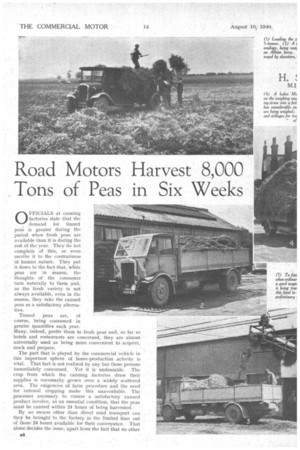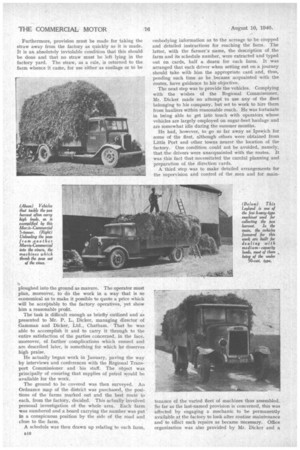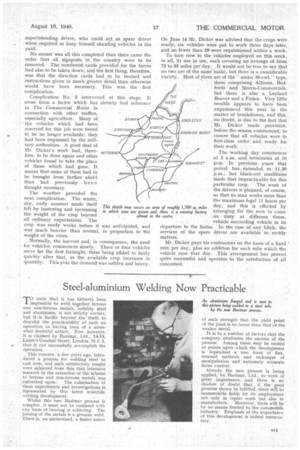Road Motors Harvest 8,000 Tons of Peas in Six Weeks
Page 26

Page 27

Page 28

Page 29

If you've noticed an error in this article please click here to report it so we can fix it.
OFFICIALS at canning factories state that the demand for tinned peas is greater during the period when fresh peas are available than it is during the rest of the year. They do not complain of this, or even ascribe it to the contrariness of human nature. They put it down to the fact that, while peas are in season, the thoughts of the consumer turn naturally to them and, as the fresh variety is not always available, even in the season, they take the canned peas as a satisfactory alternative.
Tinned peas are, of course, being consumed in greater quantifies each year Many, indeed, prefer them to fresh peas and, so far as hotels and restaurants are concerned, they are almost universally used as being more convenient to. acquire, stock and prepare.
The part that is played by the commercial vehicle in this important sphere of home-production activity is vital. That fact is not realized by any but those persons immediately concerned. Yet it is undeniable. The crop from which the canning factories draw their supplies is necessarily grown over a widely scattered area. The exigencies of farm procedure and the need for rational cropping make this unavoidable. The processes necessary to ensure a satisfactory canned product involve, as an essential condition, that the peas must be canned within 24 hours of being harvested.
By no means other than direct road transport can they be .brought to the factory in the limited time out of those 24 hours available' for their conveyance. That alone decides the issue, apart from the fact that no other
-method of transport is available in the greater part of the areas in which the crop is grown. "
The case of a typical factory may well be 6ited in support of this contention. It is situated in the middle of the district covered by the accompanying sketch map. The crops are grown within that district, and almost to its boundaries. The area covered is approximately 1,500 4 miles and many of the fields from which the crop is drawn are at least 30 miles away from the cannery.
Within that space, approximately, 1,000 acres of .peas are grown and the collection totals approximately 8,000 tons of vines, as the plant, complete with the pea pods, is called. This acreage is divided amongst no fewer than 68 farms and the acreage per farm varies from four to 40. Those farms having the largest acreage, as a rule, divide the total amongst several fields, which also may be fairly widely scattered within the area of the farm. .
The reader is asked to couple• these facts with the condition that the 'crop must be brought to the factory and canned the same day as it is harvested, and to ask himself how that could be done without the aid of motors.
Now I come to the practical problem—how to arrange for the work to be done, using mechanical transport. There are 8,000 tons to be hauled within a period which maybe seven weeks, or may be 10—at a rate, therefore. of from 130 to 200 tons per working day. The loads, according to the weight of the crop, may be anything from. 21 to 5 tons each, and the quantities may vary day • to day, according to the vagaries of the weather arid the stage of growth of the crops. Furthermore, provision must be made for taking the straw away from the factory as quickly as it is made. It is an absolutely inviolable condition that this should be done and that no straw must be left lying in the factory yard. The straw, as a rule, is returned to the farm whence it cantle, for use either as ensilage or to be ploughed into the ground as manure. The operator must plan, moreover, to do the work in a way that is so economical as to make it possible to quote a price Which will be acceptable to the factory operatives, yet show him a reasonable profit.
The task is difficult enough as briefly outlined and as presented to Mr. P. L. Dicker, managing director of Gammen and Dicker, Ltd., Chatham. That he was able to accomplish it and to carry it through to the entire satisfaction of the parties concerned, in the face, moreover, of further complications which ensued and are described later, is something for which he deserves high praise.
He actually began work in January, paving the way by interviews and conferences with the Regional Transport Commissioner and his staff. The object was principally of ensuring that supplies of petrol would be available for the work.
The ground to be covered was then surveyed. An Ordnance map of the district was purchased, the positions of the farms marked out and the best route to each, from the factory, decided. This actually involved personal investigation of the whole area. Each farm was numbered and a board carrying the number was put in a conspicuous position by the side of the road and close to the farm.
A schedule was then drawn up relating to each farm, embodying information as to the acreage to be cropped and detailed instructions for reaching the farm. The latter, with the farmer's name, the description of the farm and its schedule number, were extracted and typed out on cards, half a dozen for each farm. It was arranged that each driver when setting out on a journey should take with him the appropriate card and, thus, pending such time as he . became acquainted with the routes, have guidance to his objective.
The next step was to provide the vehicles. Complying with the wishes of the Regional Commissioner, Mr. Dicker made no attempt to use any of the fleet belonging to his company, but set to work to hire them from hauliers within reasonable reach. He was fortunate in being able to get into touch with operators whose vehicles are largely employed on sugar-beet haulage and are somewhat idle during the summer months.
He had, however, to go so far away as Ipswich for some of the fleet, although others were obtained from Little Port and other towns nearer the location of the factory. One condition could not be avoided, namely, that the drivers were unacquainted with the routes. It was this fact that necessitated the careful planning and preparation of the direction cards.
A third step was to make detailed arrangements for the supervision and control of the men and for main tenance of the varied fleet of machines thus assembled. So far as the last-named provision is concerned, this was affected by engaging a mechanic to be permanently available at the factory to look after routine maintenance and to effect such repairs as became necessary. Office organization was also provided by Mr. Dicker and a
superintending driver, who could act va's ,spare driver when required or busy himself shunting vehicles in the yard.
No sooner was all this completed than there came the order that all signposts in the country were to be removed. The numbered cards provided for the farms had also to be taken down, and the first thing, therefore, was that the direction cards had to be revised and instructions given in much• greater detail than otherwise would have been necessary. This was the first complication. •
Complication No. 2 intervened at this stage. it arose from a factor which has already had reference in The Commercial Motor in connection with other traffics, especially agriculture. Many of the vehicles which had been reserved for this job were found to be no longer available; they had been impressed by the military authorities. A good deal of Mr. Dicker's work had, therefore, to be done again and other vehicles found to take the place of those which had gone. It meant that some of them had to be brought from farther afield than had previously been thought necessary.
The weather provided the next complication. The warm, dry, early summer made itself felt by hastening and increasing the weight of the crop beyond all ordinary expectations. The crop was ready weeks before it was anticipated, and was much heavier than normal, in proportion to the weight of the vines.
Normally, the harvest and, in consequence, the need for vehicles, commences slowly. Three or four vehicles serve for the first fortnight, these -being atided to fairly quickly after that, as the available crop increases in quantity. This year the demand was sudden and heavy. On June 14 Mr. Dicker was advised that the crops were
ready; six vehicles were put to work three days later, and no fewer than 20 were requisitioned within a week.
To turn now to the vehicles employed on this work, in all, 21 are in use, each covering an average of from 75 to 85 miles per day. It would not be true to say that
no two are of the same-make, but there is a considerable Most of them are of the' under 50-cwt." type,
these comprising Albions, Bedfords and Morris-Commercials, but there is also a Leyland Beaver and a Foden. Very little trouble appears to have been experienced this year in the matter of breakdowns, and this, no doubt, is due to the fact that Mr. Dicker made provision, before the season commenced, to ensure that all vehicles were in first-class order and ready for their work.
The working day commences at 5 a.m. and terminates at 10 niewmAeeer Finn. In previous years that
period has extended to 11.30 p.m., but black-out conditions made that impracticable for this particular crop. The work of the drivers is planned, of course, so that no man works more than the maximum legal 11 hours per day, and this is effected by arranging for the men to come on duty at different times, vehicle succeeding vehicle in its departure to the farms. In the case of any hitch, the
services of the spare driver are available to rectify•
Matters.
Mr. Dicker pays his contractors on the basis of a fixed sum per day, plus an addition for each mile which the vehicle. runs that day. This arrangement hasP proved quite successful and operates to the satisfaction of all concerned.




















































